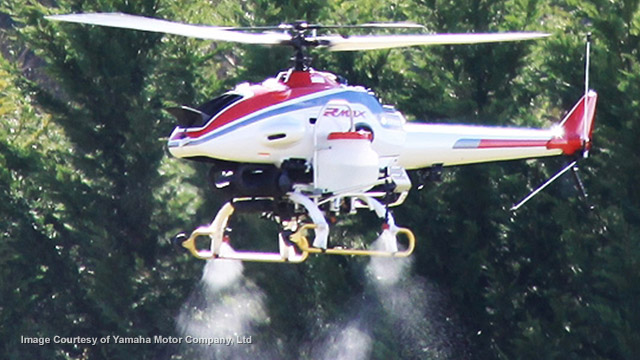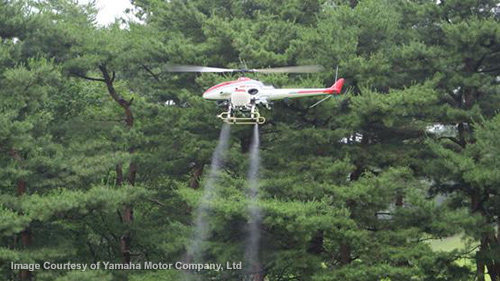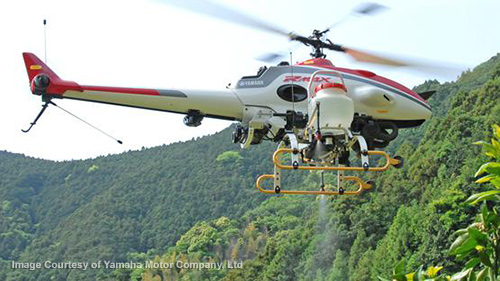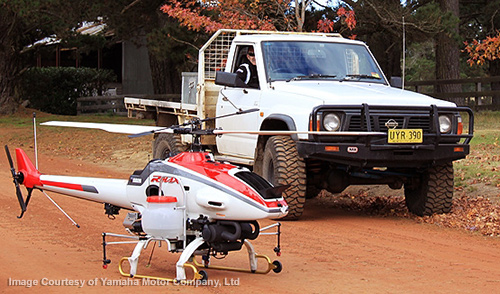Monsanto's airborne pesticide drones coming soon: FAA approves unmanned, poison-spraying helicopters
Thursday, June 25, 2015 by: Jonathan Benson, staff writer
Tags: pesticide drones, chemical agriculture, FAA

- The REAL FAKE NEWS exposed: '97% of scientists agree on climate change' is an engineered hoax... here's what the media never told you
- Polish study says vaccines have no historical benefits, continue to cause neurological damage
- TIN FOIL HAT: Washington Post claims Natural News is controlled by the Russian government
- Six little-known natural remedies for tinnitus
- Beat cancer with 35% hydrogen peroxide
- Poultry industry, like the beef industry, is steeped in evil practices
- Coconut Oil is the Antiviral of Nature
- Dandelion root extract found to kill leukemia cells, prostate cancer cells and chemo-resistant melanoma
- How I cured diabetes in five steps, and why one-third of U.S. adults will have diabetes by 2050
- Apricot Seeds Kill Cancer Cells without Side Effects
- Vitamin B-12 warning: Avoid cyanocobalamin, take only methylcobalamin
- Eliminate restless leg syndrome with home remedies and natural treatments
- The hidden dangers of caffeine: How coffee causes exhaustion, fatigue and addiction
- New study: Infants receiving the most vaccines are the most likely to be hospitalized and die
- Aajonus Vonderplanitz PhD, key informant in prosecution of Sharon Palmer and James Stewart, found to have faked academic credentials
- Natural remedies help lymphedema
- How many people have died from chemotherapy, not cancer?
- Kick influenza and colds to the curb with garlic
- The REAL FAKE NEWS exposed: '97% of scientists agree on climate change' is an engineered hoax... here's what the media never told you
- Ginger over chemo: This powerful root can eliminate 10,000x the number of cancer cells
- Sea cucumber extract kills 95 percent of breast cancer cells and shrinks lung tumors
- Untested vaccines causing new wave of polio-like paralysis across India
- Study shows nutritional supplements can cut hospital readmission rates
- Beat cancer with 35% hydrogen peroxide
- Apricot Seeds Kill Cancer Cells without Side Effects
- Polish study says vaccines have no historical benefits, continue to cause neurological damage
- Grow your own ginger for free: Natural medicine that's delicious too!
- Dr. David Gorski named in medical conspiracy allegations complaint filed with Karmanos Cancer Center and Michigan Attorney General
- The many health benefits of Moringa oleifera
- Avoid vaccines and use these top four natural remedies for flu prevention instead
- How to heal cavities naturally
- Six little-known natural remedies for tinnitus
- Man's best friend can save your life from cancer! Dogs detect cancer with 90 percent accuracy
- Discover a common yard weed that's proven to kill cancer cells
- Top 9 natural ways to heal the physical and psychological causes of depression
- Handling Pet Treats Can Cause Human Ills (press release)
- Six little-known natural remedies for tinnitus
- High-dose vitamin C injections shown to annihilate cancer
- Supplements to detox the body from vaccinations
- The REAL FAKE NEWS exposed: '97% of scientists agree on climate change' is an engineered hoax... here's what the media never told you
- Four proven natural remedies for chronic inflammation
- Beat cancer with 35% hydrogen peroxide
- Olive oil antioxidant naturally kills all cancer cells tested within an hour
- Cannabis kicks Lyme disease to the curb
- Foods that detox heavy metals - with tonic recipe
- Apricot Seeds Kill Cancer Cells without Side Effects
- Top 10 inexpensive food items that can PREVENT nearly every disease and disorder known to mankind
- Four bitter herbs heal the liver, gall bladder, and other ailments
- Curcumin causes colon cancer cells to self-destruct
- The aloe vera miracle: A natural medicine for cancer, cholesterol, diabetes, inflammation, IBS, and other health conditions
- Foods, herbs, and supplements that kill cancer - safer and more effective than drugs
- The best and worst forms of magnesium to take as a supplement
- Clear heart blockages with this powerful lemon and garlic mixture
- Untested vaccines causing new wave of polio-like paralysis across India
- EPA advisor admits the agency is funneling billions to climate groups ahead of Trump’s return to White House
- Newly released JFK files reveal Pentagon's role in creating Lyme disease and covid in the same lab
- Eleven days before Iran bombed Tel Aviv, my microscope revealed haunting images of EXACTLY what would happen
- Morphic resonance “remote viewing” reveals iconic Middle East images of stealth bombers, a falcon and a one-horned ram
- Mike Adams releases country western hit single: Goin’ Back in Time is Comin’ Home
- DECENTRALIZED SPIRITUALITY and the true teachings of Christ: Overcoming the censorship, threats and lies of organized religion to truly know God and the Universal Christ
- Global leaders unite to clamp down on “misinformation” with UN-backed Cascais Declaration
- HEALTH SECRETS: How to Instantly Block MSG Toxicity Using Natural Substances (and the secret of Methylene Blue)
- The Health Ranger releases “Vaccine Zombie” song and music video, using AI-animated zombies for the music video
- I Want My Bailout Money – new song released by Mike Adams
- BOMBSHELL: Internal Pfizer documents exposed and reveal at least 16 PERCENT of their mRNA vaccine "adverse events" are REPRODUCTIVE DISORDERS
- BOMBSHELL: DNA testing kits are a SCAM to develop ethnic-specific bioweapons
- BOMBSHELL: Covid-19 mRNA nanoparticles EMIT LIGHT SIGNALS that communicate MAC addresses used for self-assembly inside the blood vessels
- Amazing microscopy photos reveal how freezing crystals attempt to mimic electronic structures they are touching
- RFK Jr. clears key hurdle: Sen. Susan Collins backs controversial HHS nominee, signaling a new era for health policy
- The Coming Gold Revaluation: Strategic Financial Realignment in an Era of Dollar Collapse
- The AI Data Center Wars Have Begun… Farms, Water and Electricity is Stripped from Humans to Power the Machines
- Urgent Wake-Up Call: The Coming AI Robot Wars and the Great Human Unity
The helicopters, designed by Yamaha Corp. U.S.A., have an empty weight of only 141 pounds, according to a Federal Aviation Administration document,[PDF] and they don't require a human pilot. Multinational corporations like Monsanto can just load them up with Roundup and send them on their way.
"Yamaha unmanned helicopters are designed for a wide range of industrial and research applications," reads an official brochure for the new technology,[PDF] which lists "precision agriculture," "spraying" and "seeding" as potential uses.
"Your eye in the sky offers cost effective, accurate and efficient spraying with zero soil compaction," it adds.
Here you can see the "RMAX" unmanned helicopter in action as it shoots chemicals down on crops:

Unmanned drones for use in chemical agriculture represent largest civilian drones ever approved by FAA
Federal regulators were initially hesitant to approve the, drone but they eventually caved, granting a Section 333 exemption to the civilian drone on May 1. Steve Markofski, a spokesman for Yamaha Corp. U.S.A., told the Associated Press this in response:"I certainly understand their cautious approach. It's a daunting task given our airspace is complicated."
Prior to this approval, the Federal Aviation Administration (FAA) had only issued exemptions for much smaller drones weighing less than 55 pounds. In this case, the RMAX will be allowed to operate with a maximum payload of 218 pounds.
Besides having the capacity to water, fertilize and spray pesticides on crops, the RMAX can also be equipped with special sensors capable of detecting individual crop needs, such as which crops need more irrigation.
"[T]he RMAX UAS [unmanned aerial system] has been in operation since 1997 and logged more than two million flight hours," stated the FAA in conjunction with its approval. "There are approximately 2,600 RMAX UAS in use worldwide."
Dousing biotech crops in glyphosate poison will be easier than ever with unmanned drones
What this means is that chemical companies like Monsanto will have an easier time than ever ensuring that their poisons reach the crop fields of America. Drowning Roundup Ready soybean and corn crops in glyphosate will soon be as simple as the flick of a light switch -- and a real-live pilot won't even need to be present.It's a dream come true for the biotech mafia, at least when the project eventually goes live. Farmers wishing to use this ominous drone technology will still need to obtain agricultural aircraft operator certificate approval from the FAA, which has yet to take place.
Here's another image of Yamaha's RMAX chemical drone in action:

"A vehicle like this gives you a way to get in and get out and get that treatment done," stated Ken Giles, a professor biological and agricultural engineering at the University of California, Davis, who predicts that the RMAX drone will work best for precision spraying on California vineyards.
"Precision agriculture," a.k.a. automated chemical applications, will make up 80% of UAS market
Though Yamaha claims that UAS technology has a wide range of possible applications, a report by the Association for Unmanned Vehicle Systems International (AUVSI) found that so-called "precision agriculture" will make up about 80% of the domestic UAS market."Yamaha's exemption represents the first time the [FAA] has approved a UAS for crop-spraying and it is also the largest platform granted permission to operate in the US," added Brian Wynne, president and CEO of AUVSI.
The following image provides a visual comparison of the size of RMAX drone:

Sources for this article include:
http://trib.com
https://www.agriland.ie
http://rmax.yamaha-motor.com.au
http://rmax.yamaha-motor.com.au[PDF]
https://www.faa.gov[PDF]
Pesticide drones at FETCH.news
Get independent news alerts on natural cures, food lab tests, cannabis medicine, science, robotics, drones, privacy and more.
Take Action: Support Natural News by linking to this article from your website
Permalink to this article:
Embed article link: (copy HTML code below):
Reprinting this article:
Non-commercial use OK, cite NaturalNews.com with clickable link.
Follow Natural News on Facebook, Twitter, Google Plus, and Pinterest
Science News & Studies
Medicine News and Information
Food News & Studies
Health News & Studies
Herbs News & Information
Pollution News & Studies
Cancer News & Studies
Climate News & Studies
Survival News & Information
Gear News & Information
News covering technology, stocks, hackers, and more



"Big Tech and mainstream media are constantly trying to silence the independent voices that dare to bring you the truth about toxic food ingredients, dangerous medications and the failed, fraudulent science of the profit-driven medical establishment.
Email is one of the best ways to make sure you stay informed, without the censorship of the tech giants (Google, Apple, Facebook, Twitter, YouTube, etc.). Stay informed and you'll even likely learn information that may help save your own life."
–The Health Ranger, Mike Adams























